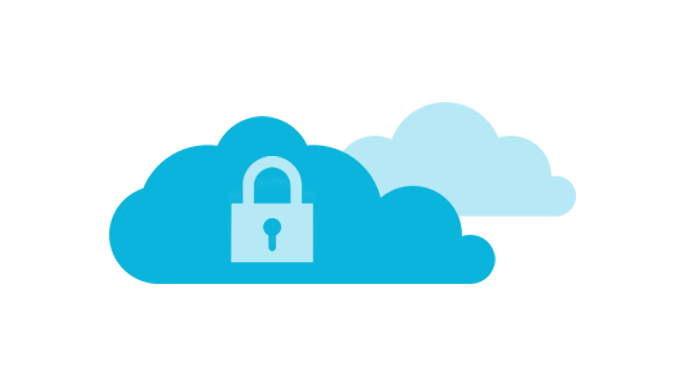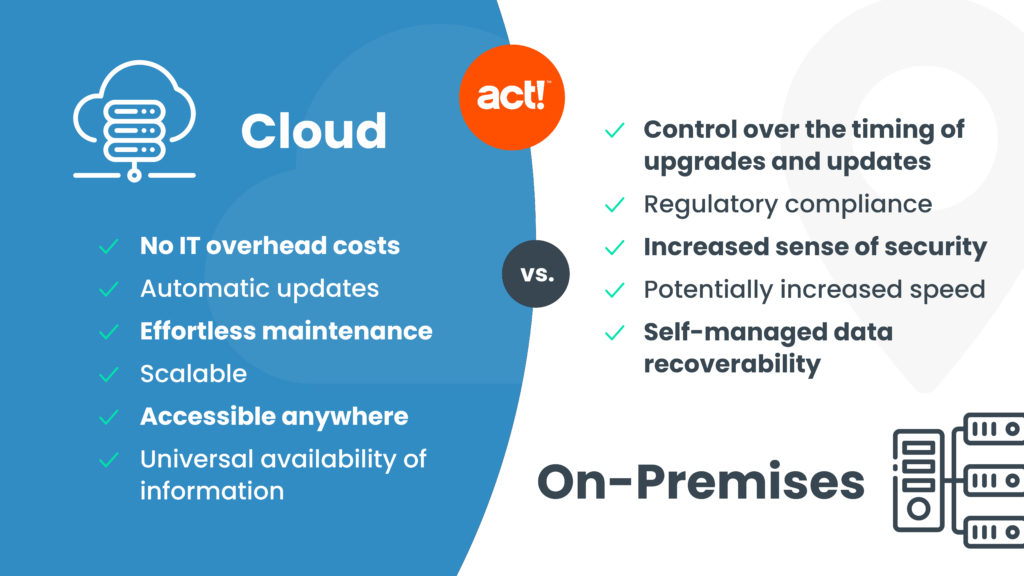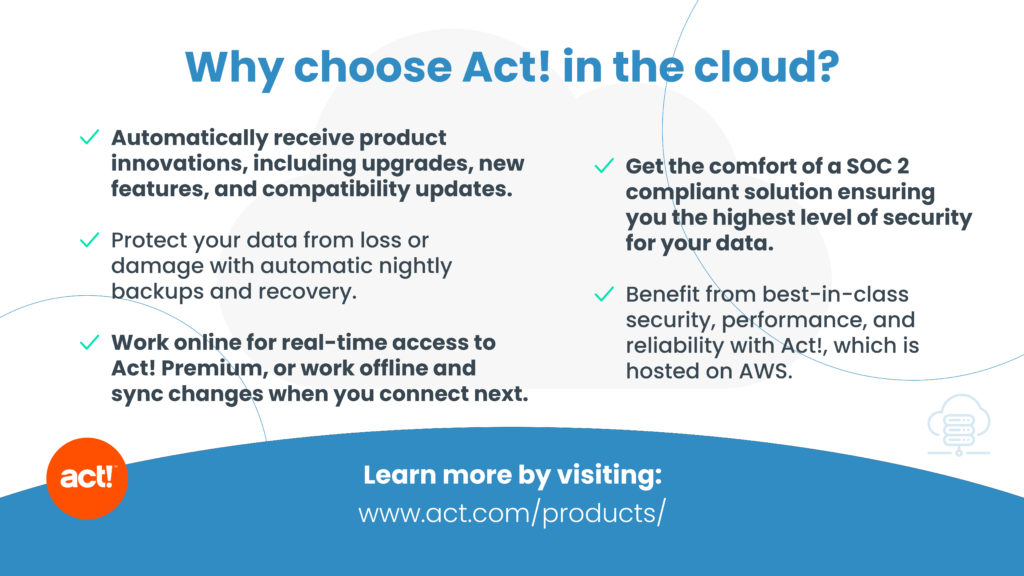
Everyone’s talking about the cloud as the place for storing data and running applications. Recently the direction of travel and working remotely has certainly been in its favor, but is it the right choice when it comes to customer relationship management software? Some are staunch cloud advocates, while others will take some persuading that on-premises solutions aren’t still the best option. But what’s the reality? Where does the balance lie? And is it a case of picking one or the other, or is there another way forward?
On-premises vs. cloud

The most obvious difference between cloud and on-premises solutions is where information and software are kept. While on-premises software deployment involves on-site servers and/or installation on local PCs or laptops, with the cloud, your data and CRM software are stored on remote servers, accessed through an internet connection.
Advantages to the Cloud
One of the major benefits of cloud software is that there are no up-front maintenance costs or expenses associated with hardware or installation expenditures, or resources to track and perform software maintenance. Another advantage of moving to the cloud is that there is effortless maintenance. Since the software resides in the cloud, all of the software’s technical elements including data backups and updates are handled by the software publisher, without any action needed by you. Scalability is a benefit of the cloud, too. The ability to scale cloud services also means that changes in your business can be accommodated much more easily, as increasing (or decreasing) cloud storage capacity is just a matter of altering your subscription. No more having to invest in expensive additional servers or IT staff. Finally, data can be accessed by those who need it, wherever they are, and constantly revised in real-time, so that everyone always has access to the most up-to-date information. This alleviates version conflicts, which can happen with on-premises software if data is altered and different versions cross in transit between colleagues.
Advantages of on-premises
A key advantage to an on-premises solution is the transparency around security. With an on-premises solution, data is typically stored in-house or on your own servers so you always know where your data resides and have control over security updates and measures. Another advantage is the ability to avoid potential third-party outages. While outages of major cloud computing services are rare, they do happen, making the fear of potential disruption to service a justified worry for companies for whom such an event would be disastrous. In addition, some businesses prefer to have complete control over when updates are deployed to the software they are using. The on-premises approach allows users to control the timing of updates and upgrades. Finally, there are other things to consider such as data recoverability, regulatory requirements around customer data, data integration, and the like.
Best of Both Worlds
There is a way to square the circle so that you get the best of both worlds and many businesses today are willing to adopt a hybrid approach that uses a mix of on-premises software and hardware, alongside public or private cloud services across their organizations. Effectively this ‘pick and mix’ approach enables you to choose the technology that works best for you, in whatever form it takes. It allows you to stick with on-premises solutions when security, or the perception of security, may be an issue, and to use cloud-based software for greater cost-effectiveness or when you need to give your off-premise team access to customer information.
And, putting in place a hybrid system can be a good option if there is an embedded organizational hesitancy about using the cloud, to prevent an “all-or-nothing” solution. Using legacy applications on up and running accounts while using cloud-based tools for new business could be a cost-effective way to move forward with minimal risk, giving you the best of both approaches. And because there are no major long-term commitments with cloud-based solutions, small businesses won’t incur large or unnecessary expenses as they test the waters to find the CRM system that works best for them.
It’s important to note that many CRM solutions are SaaS or cloud-only, while Act! offers Act! Premium, the on-premise CRM along with a variety of CRM and marketing automation deployment options including a hybrid approach that lets you work offline on your local machine or device and sync to the cloud at your convenience.
Why Act!?

Act! is a feature-rich, customizable CRM platform that offers unparalleled flexibility to accommodate all the unique ways you do business, whether you prefer an on-premises CRM or a cloud CRM. With our cloud solution, you always have instant online access to your data no matter where you are through a modern, secure AWS platform, along with the peace of mind that comes with automatic upgrades and limited upfront costs, while our on-premises solution gives you or your service provider the control to manage your data security, the location of your CRM data and decide the timing of your software updates and upgrades.
Regardless of your preferred type of CRM, Act! is the perfect CRM tool for small and midsize businesses looking to market better, sell more, and create customers for life. With unparalleled flexibility and freedom of choice, Act! accommodates all the unique ways you do business. Try Act! free for 14 days, no credit card required. Visit act.com/products for more details, or connect and talk with our team about our platform and solutions: https://www.act.com/contact-us/






